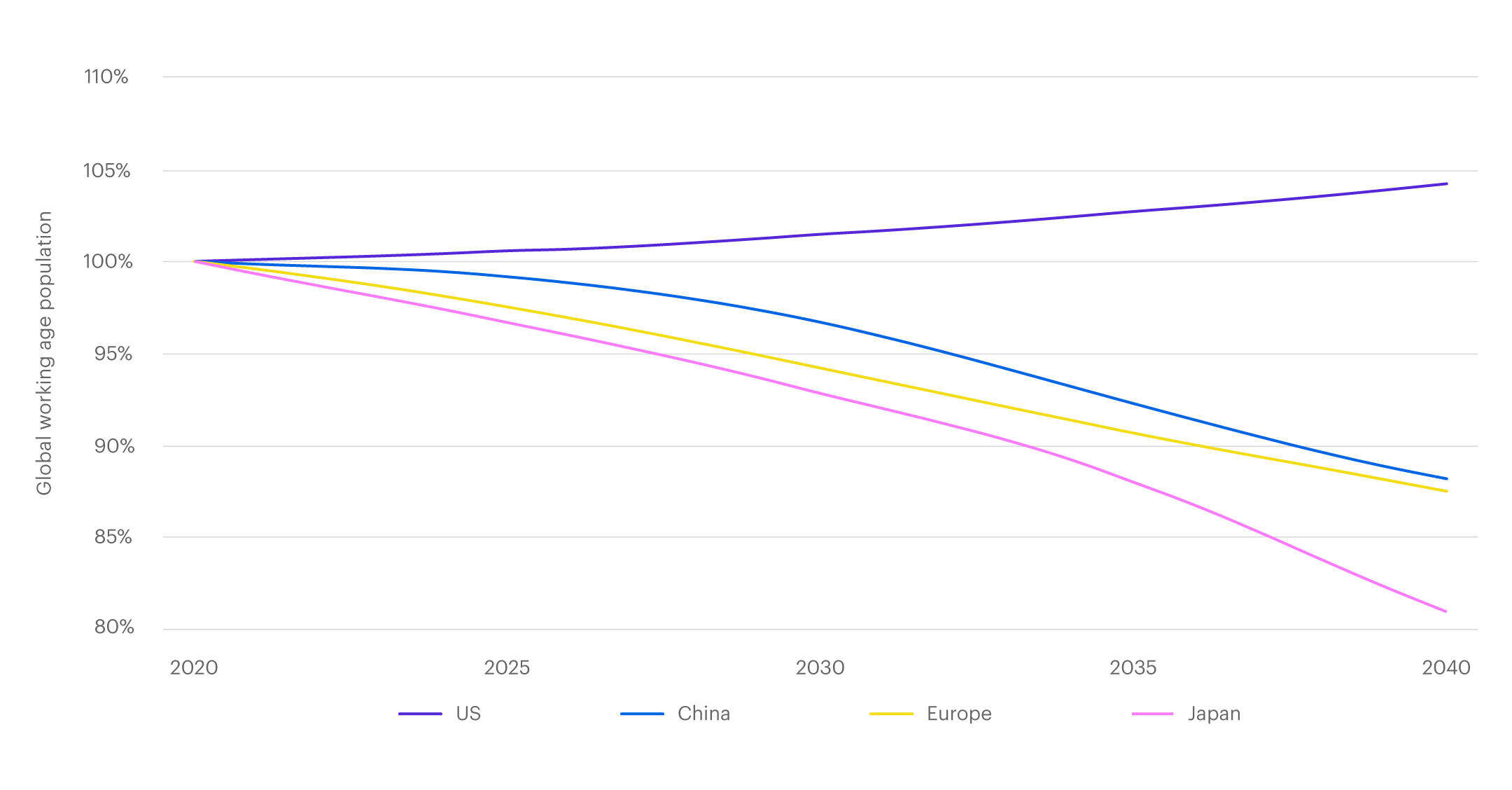Megatrends: Powering a new automation age
Morgan Stanley Wealth Management
10/10/24Summary: Aging populations and lower technology costs are propelling companies to invest more in productivity-boosting automation. What could this mean for investors?

Since well before the Industrial Revolution, technology-forward companies have looked to automation for better ways to make and deliver goods and services. And while the golden age of robotics and artificial intelligence (AI) may yet be decades in the future, today it’s these sectors that may offer potential opportunities for investors and companies alike.
What’s driving this trend? First, changing demographics. In the years ahead, automation will become a matter of necessity as shrinking working-age populations around the world drive companies to rely more on AI, machine learning, and robotics to stay productive.
Another factor: declines in cost and accelerating developments in technologies that power automation—including the recent breakthroughs in generative AI programs capable of having human-like conversations, creating articles, and even editing computer code. Now, after years of saving, many companies are primed to begin deploying capital into these technologies.
Morgan Stanley Wealth Management’s Global Investment Office believes these trends are creating exciting new opportunities for investors, tied to both the companies enabling automation as well as those harnessing its power to maintain a competitive advantage. Here’s a closer look at the key factors driving this technology megatrend and how investors may benefit.
1. Shrinking workforces are driving a greater reliance on automation
Aging populations and, in many parts of the world, a shrinking labor supply will have a material impact on the global economy in the coming decades. According to the World Bank, Europe, Japan, and China, for instance, are all forecast to see declines in their working-age populations over the next 20 years, and productivity gains will likely be necessary just to keep economic output from declining in these regions. Moreover, companies will likely find it increasingly difficult to source labor as the workforce shrinks. Stepping in to fill the gap? Automation.
This shift is playing out differently in various parts of the world:
- Europe, by 2040, is projected to see its working-age population decline 13% from its 2020 levels, likely necessitating adoption of AI and automation technologies to offset potential productivity losses.
- Japan, home to many of the world’s leading robotics firms, has seen its working-age population shrink from a peak in the mid-1990s. Yet, thanks in part to advances in factory automation and robotics, GDP today has not shrunk along with the labor supply, because productivity has increased.
- China is facing similar demographic challenges over the next two decades as its population ages and its workforce declines. Already, China’s policymakers are emphasizing productivity through urbanization, renewable energy, and continued dominance in manufacturing, all of which require investment in automation.
- The US, though its working-age population continues to grow, has been facing a persistent labor shortage that is driving companies to invest more in automation to boost productivity and offset rising labor costs.
A shrinking pool of workers could drive greater reliance on automation

Source: World Bank, Morgan Stanley Wealth Management Global Investment Office as of Oct. 20, 2021
2. Technologies powering automation are getting cheaper
Though AI, machine learning, and robotics have been around for years, the declining cost of computing has made widespread adoption of these technologies possible. What’s driving costs lower? Improvements in computer hardware components such as semiconductors and the development of more advanced software play a big role. In addition, the rise of big data has made it easier and more affordable to “train” AI to properly interpret and process vast troves of information in the complex ways needed to power automation.
A recent example is generative AI, by which computer algorithms use existing content to produce new content that appears as if it were created by humans. The technology has captured the world’s attention recently for its use in a highly sophisticated chatbot that responds to user questions with human-like answers.
Given the magnitude of computing power that is required to process this type of AI, significant investment will be needed to make the technology commercially or industrially scalable. However, Morgan Stanley Wealth Management believes that with time and technological advancement, the breakthroughs in AI could help fuel economic activity and productivity growth in the decades to come.
3. Businesses are primed to invest in technology
Historically, productivity gains in an economy tend to require a lot of investment by businesses—in things like software, equipment, and machinery. The US, for example, saw a productivity surge in the late 1990s and early 2000s, following a savings-fueled rise in capital investment in the mid-1990s.1 Now, after years of saving by businesses, Morgan Stanley Wealth Management investment strategists anticipate another boom of investment and productivity, with automation playing a central part.
So, how can you invest in automation?
For investors interested in how their portfolio can benefit from a more automated world, there are a number of approaches to consider.
Thematic exchange-traded funds (ETFs), for one, can provide broad exposure to both US and global companies involved in automation across sectors such as technology, industrials, and communications.
Those looking for specific companies to invest in may want to consider two key themes Morgan Stanley & Co. Research analysts have identified:
- “Data Era” beneficiaries—companies enabling or adopting data-harnessing technologies that will change how businesses collect, analyze, and act on information to drive productivity growth. Explore companies involved in the production of technologies such as artificial intelligence, machine learning, and robotics.
- Leaders in the “Second Machine Age”—companies tied to rising industrial productivity, including those focused on industrial automation. Products supporting factory and process automation, for example, sorting technology, monitoring and safety systems, and programmable logic controllers (PLCs) could be contributors.
- “Deflation Enablers”—Although the AI industry is still in its early stages and generally not directly investible through public markets, there will likely be significant potential investment opportunities in the decade ahead. Look for opportunities with companies that are producing technologies to reduce business costs and increase productivity, particularly in automation and digitization, where barriers to entry are high.
Morgan Stanley Wealth Management sees compelling opportunities not only in technology companies that are enabling automation, but also in non-tech firms that are investing heavily in automation to boost productivity and profits. These “automation adopters” may be under-appreciated beneficiaries of this technology megatrend.
Finally, when considering if and how an investment fits into your portfolio, make sure to keep individual goals, timelines, and risk tolerance top of mind.
The source of this Morgan Stanley article, Megatrends: Powering a New Automation Age, was originally published on 03/21/23.
CRC# 3813638 10/2024
How can E*TRADE help?

Artificial intelligence
Find investing opportunities in this growing field of technology.

Morgan Stanley Financial Advisors
Eligible clients can work with a Morgan Stanley Financial Advisor to access timely investment ideas and insights from Morgan Stanley’s team of leading analysts, economists, and strategists.